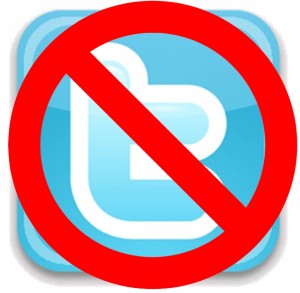 NEWS
NEWS
 NEWS
NEWS
 NEWS
NEWS
![]() Social networking sites give users the option to block some people. This is a useful feature in cases when people are harassing you, a friend has fallen out with you, someone irritates you with their nonsense posts, or just don’t want a particular person to see you.
Social networking sites give users the option to block some people. This is a useful feature in cases when people are harassing you, a friend has fallen out with you, someone irritates you with their nonsense posts, or just don’t want a particular person to see you.
But what if these blocking options don’t really block people at all? What if you couldn’t see them, but they could still follow your every move? Wouldn’t that defeat the object of blocking them in the first place, not too mention, piss you off a little?
As ridiculous and pointless as it sounds, that’s what Twitter actually attempted to do yesterday when it announced changes to its blocking policy – as a result, ‘blocked’ people wouldn’t be blocked at all. They’d still be able to see the person they were blocked from following, interact with their tweets, and retweet, even though that person doesn’t want them to. Prior to this, blocked people on Twitter could not see the person that blocked them, unless they logged off of the site.
Not surprisingly, this change in the blocking policy angered many Twitter users as this poses problems, especially for those who’ve been dealing with harassment. What happened with the change was that it allowed the blocked people to continue harassing those that blocked them without their knowledge.
If you block someone, Twitter won’t send the blocked person a notification that he or she has been blocked. But with the change, a blocked person will not immediately know that he or she has been blocked, since they can still interact with tweets and see that person’s activities. So determining if you have been blocked has been delayed. Previously, you’ll immediately know that you’ve been blocked since you won’t be able to see the person you are stalking or harassing.
So why did Twitter change it in the first place? Twitter looked at the other side of the story, the angle of the blocked person. In some cases, when a person finds out that he has been blocked, he retaliates and finds other ways of harassing the person that blocked them. Twitter wanted to eliminate that scenario so it figured that if the blocked person doesn’t know that he has been blocked, harassment won’t escalate. What Twitter failed to see is that the person who blocked the other party may be put at greater risks. Stalkers can now stalk without the other party’s knowledge.
The onslaught of concerned Twitter users prompted an emergency meeting of Twitter’s bosses, and resulted in the site reverting back to the old policy.
“In reverting this change to the block function, users will once again be able to tell that they’ve been blocked. We believe this is not ideal, largely due to the retaliation against blocking users by blocked users (and sometimes their friends) that often occurs. Some users worry just as much about post-blocking retaliation as they do about pre-blocking abuse. Moving forward, we will continue to explore features designed to protect users from abuse and prevent retaliation,” Twitter explained in its blog.
Twitter is now working on the kinks to make a better and safer service for everyone.
Support our open free content by sharing and engaging with our content and community.
Where Technology Leaders Connect, Share Intelligence & Create Opportunities
SiliconANGLE Media is a recognized leader in digital media innovation serving innovative audiences and brands, bringing together cutting-edge technology, influential content, strategic insights and real-time audience engagement. As the parent company of SiliconANGLE, theCUBE Network, theCUBE Research, CUBE365, theCUBE AI and theCUBE SuperStudios — such as those established in Silicon Valley and the New York Stock Exchange (NYSE) — SiliconANGLE Media operates at the intersection of media, technology, and AI. .
Founded by tech visionaries John Furrier and Dave Vellante, SiliconANGLE Media has built a powerful ecosystem of industry-leading digital media brands, with a reach of 15+ million elite tech professionals. The company’s new, proprietary theCUBE AI Video cloud is breaking ground in audience interaction, leveraging theCUBEai.com neural network to help technology companies make data-driven decisions and stay at the forefront of industry conversations.